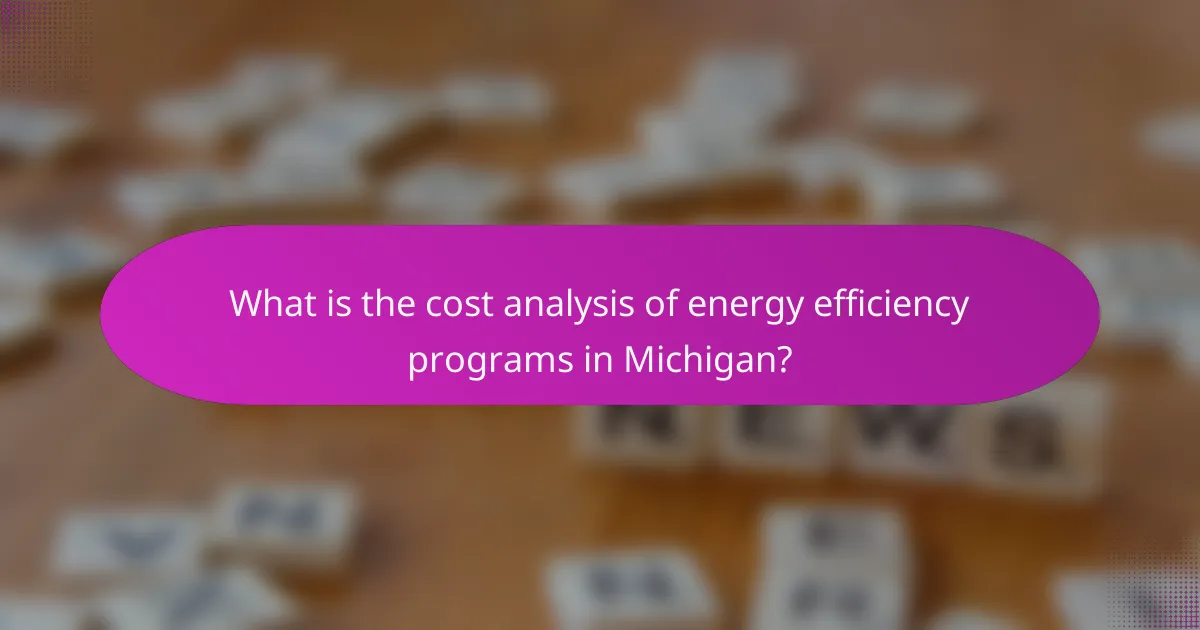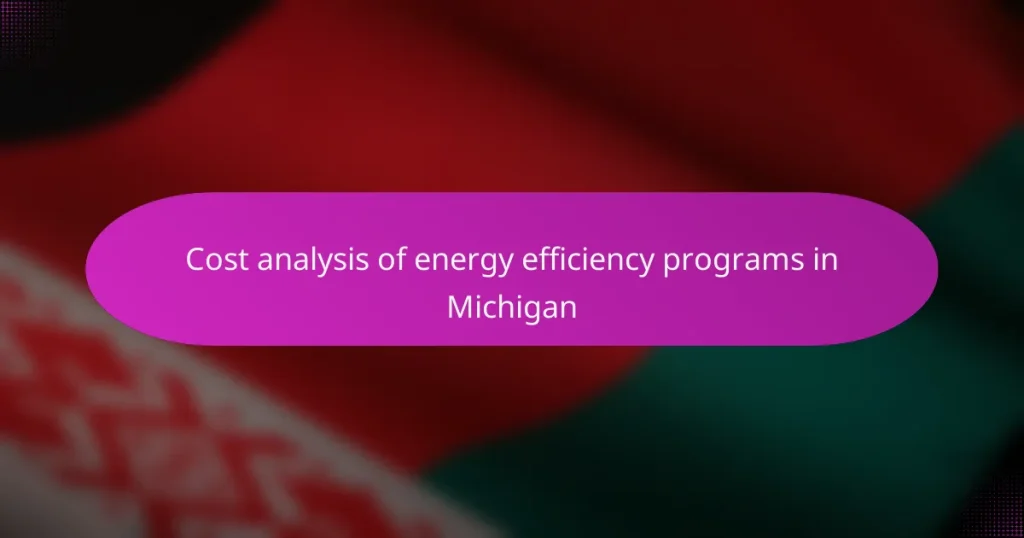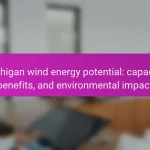
What is the cost analysis of energy efficiency programs in Michigan?
The cost analysis of energy efficiency programs in Michigan indicates that these initiatives yield significant economic benefits. A study by the Michigan Public Service Commission shows that for every dollar invested in energy efficiency programs, there is an estimated return of $2.50 in savings. The programs target residential, commercial, and industrial sectors, leading to reduced energy consumption and lower utility bills.
In 2020, Michigan invested approximately $300 million in various energy efficiency programs. These investments have led to energy savings of over 1.3 billion kilowatt-hours annually. The analysis also highlights that energy efficiency programs help create jobs, with thousands of positions generated in the energy sector.
Additionally, the cost-effectiveness of these programs is supported by a reduction in greenhouse gas emissions, contributing to environmental sustainability. Overall, the financial assessment demonstrates that energy efficiency programs in Michigan are not only cost-effective but also beneficial for the economy and the environment.
How are energy efficiency programs defined in Michigan?
Energy efficiency programs in Michigan are defined as initiatives aimed at reducing energy consumption and promoting sustainable practices. These programs are implemented by utility companies and government agencies. They focus on providing incentives for energy-saving technologies and practices. Examples include rebates for energy-efficient appliances and home retrofits. The Michigan Public Service Commission oversees these programs to ensure compliance with state regulations. According to the Michigan Energy Efficiency Act, utilities must achieve specific energy savings targets. These targets contribute to overall energy conservation goals in the state.
What types of energy efficiency programs are available in Michigan?
Michigan offers several types of energy efficiency programs. These programs include residential energy audits, which assess home energy use and suggest improvements. There are also incentives for upgrading insulation and windows to reduce energy consumption.
Commercial energy efficiency programs are available for businesses to improve their energy performance. The state provides rebates for energy-efficient appliances and lighting upgrades. Additionally, utility companies in Michigan offer various programs to encourage energy-saving measures.
According to the Michigan Public Service Commission, these initiatives aim to reduce energy waste and lower utility costs for consumers.
What are the goals of these programs?
The goals of energy efficiency programs in Michigan are to reduce energy consumption and lower utility bills for consumers. These programs aim to enhance the reliability of the energy supply. They also seek to decrease greenhouse gas emissions, contributing to environmental sustainability. Additionally, the programs focus on improving the overall energy efficiency of homes and businesses. By doing so, they help stimulate economic growth through job creation in the energy sector. The Michigan Public Service Commission reports that these initiatives lead to significant energy savings and cost reductions for participants.
Why is cost analysis important for energy efficiency programs?
Cost analysis is crucial for energy efficiency programs because it ensures effective allocation of resources. By evaluating costs, programs can identify the most cost-effective measures for energy savings. This analysis helps in prioritizing investments that yield the highest returns. According to the American Council for an Energy-Efficient Economy, cost-effective energy efficiency measures can save consumers up to $1.5 trillion by 2030. Additionally, cost analysis allows for better program design and implementation, ensuring that funds are used efficiently. It also aids in measuring the economic impact of energy efficiency initiatives on local communities. Therefore, thorough cost analysis is essential for maximizing benefits while minimizing expenses in energy efficiency programs.
How does cost analysis impact program funding and implementation?
Cost analysis significantly influences program funding and implementation by providing a framework for evaluating financial viability. It helps stakeholders assess the cost-effectiveness of energy efficiency programs. A thorough cost analysis identifies potential savings and expenses associated with program execution. This information is crucial for securing funding from government or private sources. For example, programs demonstrating high return on investment are more likely to attract financial support. Additionally, cost analysis informs budget allocation and resource management during implementation. Accurate cost projections can prevent budget overruns and ensure efficient use of funds. As a result, effective cost analysis leads to more successful energy efficiency initiatives in Michigan.
What metrics are used in cost analysis of these programs?
Cost analysis of energy efficiency programs in Michigan uses several key metrics. Common metrics include cost per kilowatt-hour saved, total program cost, and net present value. Cost per kilowatt-hour saved measures the efficiency of energy savings relative to the program’s costs. Total program cost encompasses all expenses associated with implementation, including administrative costs. Net present value evaluates the profitability of the program by comparing future cash flows to initial costs. These metrics help stakeholders assess the financial viability and effectiveness of energy efficiency initiatives.
What are the key components of cost analysis for these programs?
The key components of cost analysis for energy efficiency programs in Michigan include initial investment costs, operational costs, and maintenance costs. Initial investment costs encompass expenses related to equipment purchase and installation. Operational costs involve ongoing expenses such as energy consumption and labor. Maintenance costs are related to the upkeep of equipment and systems over time. Additionally, the analysis must consider potential savings from energy reductions and the overall return on investment. The evaluation of these components helps determine the program’s financial viability and effectiveness in reducing energy consumption.
What costs are considered in the analysis?
The costs considered in the analysis of energy efficiency programs in Michigan include installation costs, operational costs, and maintenance costs. Installation costs encompass expenses related to equipment purchase and labor for setup. Operational costs refer to ongoing expenses such as energy consumption and system performance monitoring. Maintenance costs involve periodic repairs and servicing of the installed systems. These cost categories are essential to evaluate the overall financial impact of energy efficiency programs. Accurate cost assessment helps in determining the return on investment and effectiveness of such initiatives.
How is the effectiveness of energy savings measured?
The effectiveness of energy savings is measured through various metrics and methodologies. Commonly used methods include comparing energy consumption before and after implementing energy-saving measures. This comparison often utilizes baseline data collected over a specific period.
Energy savings are quantified in kilowatt-hours (kWh) or therms saved. Additionally, evaluation frameworks may include cost-effectiveness analysis and return on investment (ROI) calculations. These frameworks help determine the financial benefits relative to the costs incurred.
For example, the Michigan Public Service Commission employs standardized evaluation protocols for energy efficiency programs. This includes the use of the International Performance Measurement and Verification Protocol (IPMVP) to ensure accurate assessment. The results from these evaluations provide insights into the overall effectiveness and impact of energy efficiency initiatives in Michigan.
How do energy efficiency programs affect Michigan’s economy?
Energy efficiency programs positively impact Michigan’s economy by reducing energy costs for consumers and businesses. These programs lead to lower utility bills, which increases disposable income. Increased disposable income can stimulate local spending and economic growth. Additionally, energy efficiency initiatives create jobs in the installation and maintenance of energy-saving technologies. According to the Michigan Public Service Commission, energy efficiency programs saved consumers about $1.4 billion from 2013 to 2018. These savings contribute to overall economic stability and growth. Furthermore, energy efficiency can enhance the competitiveness of Michigan businesses by reducing operational costs. Overall, these programs support a sustainable economic environment in Michigan.
What are the economic benefits of implementing these programs?
Implementing energy efficiency programs in Michigan yields significant economic benefits. These programs reduce energy consumption, leading to lower utility bills for consumers. According to the American Council for an Energy-Efficient Economy, energy efficiency measures can save households an average of $500 annually.
Additionally, these programs create jobs in the energy sector. A report from the Michigan Energy Office indicated that energy efficiency initiatives created over 5,000 jobs in 2020 alone.
Moreover, the programs stimulate local economies by reinvesting savings into communities. This reinvestment can enhance local business growth and infrastructure development.
Finally, energy efficiency programs help reduce greenhouse gas emissions, which can lead to long-term savings in health care costs associated with pollution. The Michigan Department of Environment, Great Lakes, and Energy reported that reducing emissions could save the state millions in health-related expenses.
How do these programs create jobs in Michigan?
Energy efficiency programs create jobs in Michigan by promoting retrofitting and upgrading existing buildings. These projects require skilled labor for installation and maintenance. Additionally, the programs stimulate demand for energy-efficient products, boosting local manufacturing. According to a report by the Michigan Public Service Commission, these initiatives have led to thousands of job placements in the construction and energy sectors. Furthermore, the investment in energy efficiency generates economic activity, leading to indirect job creation in related industries. Overall, the focus on energy efficiency translates to a measurable increase in employment opportunities across the state.
What challenges exist in the cost analysis of energy efficiency programs?
Challenges in the cost analysis of energy efficiency programs include accurately estimating savings, measuring program impacts, and accounting for long-term benefits. Estimating savings can be difficult due to varying consumer behaviors and market conditions. Measuring program impacts often requires complex methodologies, which can lead to discrepancies. Additionally, long-term benefits such as reduced energy costs and environmental impacts are hard to quantify. These challenges can result in underestimating or overestimating program costs and benefits. For instance, a study by the American Council for an Energy-Efficient Economy highlights that inconsistent data collection methods can skew results.
What factors complicate accurate cost assessment?
Factors that complicate accurate cost assessment include variability in energy savings estimates. Different methodologies yield diverse results. Additionally, fluctuating energy prices can impact cost calculations. The duration of energy efficiency measures also varies, affecting long-term assessments. Furthermore, behavioral changes among consumers can alter expected savings. Limited data availability poses challenges in making informed estimates. Lastly, program implementation costs may differ across regions, complicating comparisons.
How can these challenges be addressed?
Challenges in energy efficiency programs in Michigan can be addressed through targeted policy adjustments and stakeholder engagement. Implementing comprehensive education campaigns can enhance public understanding and participation. Financial incentives, such as rebates or tax credits, can motivate both consumers and businesses to adopt energy-efficient technologies. Collaborating with local utilities can streamline program delivery and increase access to resources. Additionally, regular evaluation and adjustment of programs based on performance data can ensure ongoing effectiveness. Research indicates that states with proactive energy efficiency policies see higher participation rates and cost savings. For example, Michigan’s energy efficiency programs are designed to achieve a 1% reduction in electricity sales annually, demonstrating a commitment to overcoming these challenges.
What are the future trends in energy efficiency program cost analysis in Michigan?
Future trends in energy efficiency program cost analysis in Michigan include increased use of data analytics and predictive modeling. These methods enhance the accuracy of cost assessments. The integration of advanced technologies will streamline program evaluations. Additionally, there is a growing emphasis on measuring long-term impacts rather than just short-term savings. This shift allows for a more comprehensive understanding of program effectiveness. Stakeholder engagement will also play a crucial role in shaping future analyses. Collaborative approaches will help align goals among utilities, policymakers, and consumers. Furthermore, Michigan’s energy policies are increasingly focused on sustainability and equity. This focus will influence cost analysis frameworks to ensure inclusive benefits across diverse communities. Overall, these trends indicate a move towards more sophisticated and equitable cost analysis practices in Michigan’s energy efficiency programs.
How is technology influencing cost analysis methodologies?
Technology is significantly influencing cost analysis methodologies by enhancing data collection and analysis capabilities. Advanced software tools enable real-time data tracking, which improves accuracy in cost assessments. Automation reduces manual errors and speeds up the analysis process. Machine learning algorithms can identify patterns in large datasets, allowing for more informed decision-making. Cloud computing facilitates collaboration among stakeholders, streamlining the sharing of information. Additionally, visualization tools help present complex data in an understandable format. These advancements lead to more efficient and effective cost analysis in energy efficiency programs in Michigan.
What role do policy changes play in shaping future analyses?
Policy changes significantly influence future analyses of energy efficiency programs. They can alter funding levels, regulatory requirements, and program goals. For example, a shift in state policy may increase incentives for energy efficiency investments. This, in turn, leads to more comprehensive data collection and evaluation methods. Historical data shows that policy adjustments often result in revised cost-benefit analyses. In Michigan, changes in energy policy have previously affected program participation rates and cost savings estimates. Therefore, understanding policy dynamics is essential for accurate future analyses.
What best practices should be considered in conducting cost analyses for energy efficiency programs?
Best practices for conducting cost analyses for energy efficiency programs include using standardized methodologies. These methodologies ensure consistency and comparability across different programs. It is important to account for both direct and indirect costs. Direct costs include materials and installation, while indirect costs may encompass administrative expenses. Utilizing a life-cycle cost analysis is essential. This approach evaluates costs over the entire lifespan of the energy efficiency measures. Incorporating risk assessments can help identify uncertainties in cost projections. Engaging stakeholders during the analysis process can provide valuable insights. Finally, regularly updating the analysis with new data enhances accuracy and relevance.
How can stakeholders collaborate for effective analysis?
Stakeholders can collaborate for effective analysis by establishing clear communication channels. Regular meetings and updates ensure all parties are aligned. Sharing data and resources enhances the quality of analysis. Utilizing collaborative software tools can streamline the process. Engaging in joint workshops fosters a deeper understanding of objectives. Clearly defined roles and responsibilities help avoid overlap and confusion. Collectively reviewing findings leads to more comprehensive insights. This collaborative approach is vital for informed decision-making in energy efficiency programs.
What resources are available for improving cost analysis accuracy?
Resources for improving cost analysis accuracy include software tools, training programs, and industry guidelines. Software like Energy Star Portfolio Manager helps track energy use and costs. Training programs from organizations like the Association of Energy Engineers enhance skills in cost estimation. Industry guidelines, such as those from the American Council for an Energy-Efficient Economy, provide best practices for cost analysis. Utilizing these resources can lead to more precise cost assessments in energy efficiency programs.
The main entity of this article is the cost analysis of energy efficiency programs in Michigan. The article provides a detailed examination of the economic benefits and effectiveness of these programs, highlighting that for every dollar invested, there is an estimated return of $2.50 in savings. It discusses the types of programs available, their goals, and the metrics used for cost analysis, while also addressing the impact on Michigan’s economy, job creation, and environmental sustainability. Additionally, the article outlines the challenges faced in cost assessment and the future trends in energy efficiency program analysis.


